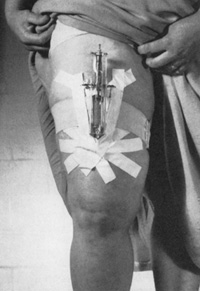
Am Fam Physician. 2000;61(4):924
This feature is part of a year-long series of excerpts and special commentaries celebrating AFP's 50th year of publication. Excerpts from the two 1950 volumes of GP, AFP's predecessor, appear along with highlights of 50 years of family medicine.
This feature contains excerpts from the article “Streptomycin and the Multidose Injector,” by Nathan Steinberg, M.D., published in the August 1950 issue of GP , and commentary by Amy S. Weichel, D.O., editorial fellow of AFP.
The question how to treat the patient requiring the administration of streptomycin at frequent intervals in the home or office has recently been answered. A new method of continuous antibiotic therapy by means of a syringe with a needle in situ now permits equally efficacious use of streptomycin in the home, office, or hospital outpatient clinic. This mechanical device fits about a conventional 5-cc. syringe which limits automatically the thrust of the plunger. The instrument and attached curved needle, with its penetration limited to 1/4-inch by means of rubber tubing, remain in situ for 24 hours.
When compelled to treat a serious illness in the home, it was felt that the prompt recovery of the patient rather than any minor inconvenience should be the deciding factor. Although a technique may appear uncomfortable or annoying to the physician, it is not objected to by the average patient, providing recovery can thereby be hastened. One is constantly made aware of this fact when he sees patients receiving up to a gram of streptomycin daily by means of a constant indwelling needle in the thigh, not only while walking to the office but even occasionally while carrying on household duties.—NATHAN STEINBERG, M.D.

Commentary
“High tech,” a catch-phrase in recent years, makes us think of cutting-edge technology and the newest and best of inventions. In the 1990s and now in Y2K, “high tech” certainly makes us think of computers and the Internet. However, medicine has not escaped this technology boom. We are now able to do things that probably seemed impossible 50 years ago—magnetic resonance imaging, laparoscopic surgery, angioplasty—the list could go on and on. Interestingly, the multidose injector, which is described above, was probably considered “high tech” back in the 1950s. This large and clumsy apparatus, which was strapped to the thigh, allowed patients to receive multiple doses of (subcutaneous) antibiotics at home. What a wonderful new concept in medicine! People with infections requiring prolonged antibiotics were now able to get treatment at home or in the office, at a time when it was not uncommon to admit patients for sebaceous cysts or simple lacerations. If we just consider the advances in vascular access and outpatient antibiotic therapy, we see that the new technology is astounding. Gone are the days of such big and bulky contraptions like the multidose injector. Today with the advent of PICC lines (peripherally inserted central catheters), central lines and subcutaneous ports, outpatient antibiotic therapy has become much more safe and effective. Who knows what great new inventions will occur in the next 50 years? Undoubtedly, our current hot new technology will be considered terribly outdated by then.—amy s. weichel, d.o.